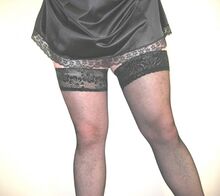Medicine:Transvestic fetishism
| Transvestic fetishism | |
|---|---|
 | |
| Specialty | Psychiatry |
| Symptoms | Excessive sexual or erotic interest in cross-dressing |
Transvestic fetishism is a psychiatric diagnosis applied to those who are thought to have an excessive sexual or erotic interest in cross-dressing; this interest is often expressed in autoerotic behavior. It differs from cross-dressing for entertainment or other purposes that do not involve sexual arousal. Under the name transvestic disorder, it is categorized as a paraphilia in the DSM-5.[1]
Description
The DSM-5 states that adolescent and adult males with late-onset gender dysphoria "frequently engage in transvestic behavior with sexual excitement."[2] "Habitual fetishistic transvestism developing into autogynephilia" is given as a risk factor for gender dysphoria to develop.
According to DSM-IV, this fetishism was limited to heterosexual men; however, the DSM-5 does not have this restriction, and opens it to women and men with this interest, regardless of their sexual orientation.[3] It is, however, usually documented in males.[4]
There are two key criteria before a psychiatric diagnosis of "transvestic fetishism" is made:[5]
- Individuals must be sexually aroused by the act of cross-dressing.
- Individuals must experience significant distress or impairment – socially or occupationally – because of their behavior.
Types
Some male transvestic fetishists collect women's clothing, e.g. panties, nightgowns, babydolls, bridal gowns, slips, petticoats, brassieres, and other types of nightwear, lingerie, stockings, pantyhose, shoes, and boots, items of a distinct feminine look and feel, especially of silk, satin and lace. They may dress in these feminine garments and take photographs of themselves while living out their fantasies.
See also
- Dual-role transvestism
- Feminization
- Hair fetishism
- List of transgender-related topics
- List of paraphilias
- Pinafore eroticism
- Transgender
- Transvestism
References
- Citations
- ↑ American Psychiatric Association (2013). Diagnostic and Statistical Manual of Mental Disorders (Fifth ed.). Arlington, VA: American Psychiatric Publishing. pp. 685–705. ISBN 978-0-89042-555-8. https://archive.org/details/diagnosticstatis0005unse/page/685.
- ↑ Diagnostic and Statistical Manual of Mental Disorders (Fifth ed.). Arlington, VA: American Psychiatric Publishing. 2013. pp. 451–460. ISBN 978-0-89042-554-1. https://archive.org/details/diagnosticstatis0005unse/page/451.
- ↑ http://www.dsm5.org/Documents/Paraphilic%20Disorders%20Fact%20Sheet.pdf DSM-5 Documents: Paraphilic Disorders Fact Sheet
- ↑ Shorter Oxford Textbook of Psychiatry. OUP Oxford. 2012. p. 373. ISBN 978-0191626753. https://books.google.com/books?id=Y1DtSGq-LnoC&pg=PA373.
- ↑ American Psychiatric Association. (2000). Diagnostic and Statistical Manual of Mental Disorders (4th ed., text rev.). Washington, DC: American Psychiatric Publishing.
- Sources
- Laws, Richard D.; O'Donohue, William T., eds (2008). Sexual Deviance: Theory, Assessment, and Treatment (2 ed.). New York: Guilford Press. ISBN 978-1-59385-605-2.



